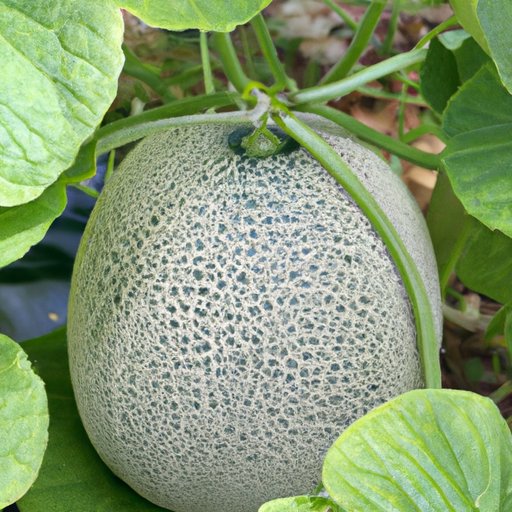
I. Introduction
Cantaloupe is a popular fruit, especially during the summer months when it is in season. However, despite its popularity, it is not always easy to determine if a cantaloupe is ripe before purchasing or picking it. Identifying a ripe cantaloupe is important because an unripe one may not have fully developed its flavor and sweetness. In this article, we will explore visual, scent, and touch cues to help you tell when cantaloupe is ripe. We will also provide tips on picking, storing, and preserving ripe cantaloupes for maximum enjoyment.
II. Visual cues of ripeness
One of the first things to look for when trying to identify a ripe cantaloupe is visual cues. Here are some physical changes to the skin, appearance of the stem, and overall coloring of the fruit that can indicate its ripeness:
- The skin of a ripe cantaloupe will have changed from green to beige or tan. You may also notice a slight yellow hue.
- The webbing on the outside of the cantaloupe will become more pronounced as it ripens.
- The stem should be smooth and slightly indented. If the stem is still green, it is probably not yet fully ripe.
- A ripe cantaloupe should feel slightly heavy for its size.
To identify these visual cues, be sure to examine the fruit from all angles and use your fingers to feel for changes in texture. A fully ripe cantaloupe should not have any visible bruises, cuts, or soft spots on its skin.
III. Scent of a ripe cantaloupe
In addition to visual cues, scent is another important factor in identifying a ripe cantaloupe. The aroma of a ripe cantaloupe is distinct and sweet. Here are some tips for identifying the right scent:
- Hold the cantaloupe close to your nose and gently sniff. A ripe cantaloupe will have a strong, sweet fragrance.
- If the scent is faint or not present at all, the cantaloupe is likely not yet ripe.
- If the cantaloupe has a sour or fermented smell, it is likely overripe or spoiled.
Keep in mind that the scent of a ripe cantaloupe can vary based on factors such as the variety, growing conditions, and storage. However, the general sweet and fragrant smell is what you should be looking for to identify ripeness.
IV. Testing for ripeness by touch
Another method to determine cantaloupe ripeness is by touching it. Here are some tips to identify a ripe cantaloupe by touch:
- A ripe cantaloupe should feel slightly soft and yield to gentle pressure. Press gently on the end opposite the stem with your thumb – if it gives slightly, it’s probably ripe.
- If the fruit is hard or does not give at all, it is likely not yet fully ripe.
- Be careful not to apply too much pressure, as this may damage the fruit.
Remember that a ripe cantaloupe should not have any soft spots or bruises.
V. Timing for picking a cantaloupe
The timing of when to check for ripeness depends on several factors like temperature and humidity. Here are some guidelines to follow when picking a cantaloupe:
- Check for ripeness when the cantaloupe is at its peak season, usually in the summer months.
- If you are purchasing a cantaloupe from a store, look for one that has a slight give when you apply pressure. This indicates that it is ripe and ready to eat.
- If you are harvesting your own cantaloupe, check it daily when it begins to mature. Look for the visual, scent, and touch cues we covered in the previous sections.
Remember that the longer you wait to pick a cantaloupe, the sweeter and more tender it will become. However, if you wait too long, it may become overripe and begin to rot.
VI. Storage and preservation of ripe cantaloupes
Once you have identified a ripe cantaloupe, it is important to store it properly to extend its shelf-life and preserve its flavor and texture. Here are some tips for storing and preserving ripe cantaloupes:
- Store a ripe cantaloupe in the refrigerator to slow further ripening and prevent spoilage. It can be kept for up to a week in the refrigerator.
- Wash the cantaloupe before slicing it open, as the skin can harbor bacteria that can cause foodborne illness.
- Try using ripe cantaloupes in recipes like fruit salads, smoothies, or as a topping for yogurt or oatmeal.
- Freeze the cantaloupe in slices or chunks for later use in smoothies or as a refreshing snack.
Remember to remove any seeds or rind before consuming the cantaloupe.
VII. Conclusion
In summary, identifying a ripe cantaloupe is important for maximum enjoyment of this delicious fruit. Visual, scent, and touch cues are all important factors to consider when trying to determine a cantaloupe’s ripeness. Be sure to store and preserve ripe cantaloupes properly to extend their shelf-life. With these tips, you can confidently pick and enjoy ripe cantaloupes all summer long.




